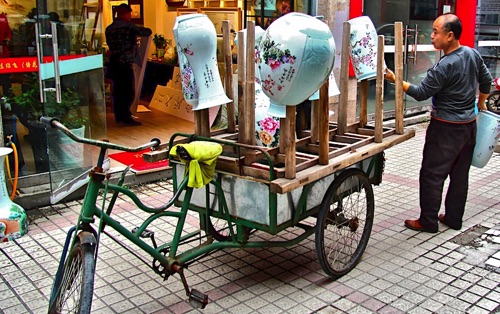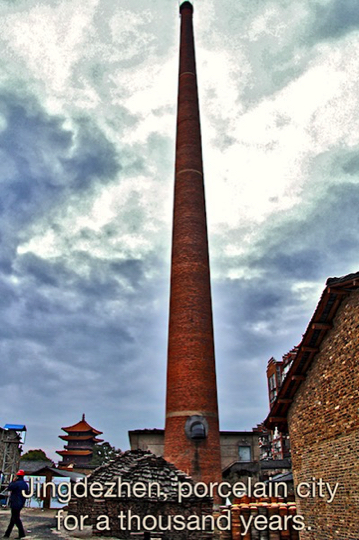Home
KASHBA Asiatica
Ais Loupatty & Ton Lankreijer
Staalstraat 6
1011 JL Amsterdam
Open 12:00 – 17:00
Zondag / Sunday 14:00 - 17:00
Contact:
31-20- 6 23 55 64
































































































All photographs and texts ©Kashba Ais Loupatty & Ton Lankreijer.Webdesign:William Loupatty

Incomprehensible. Where in the world can you find a city where almost everyone has his or her hands in the clay? Sculpting, spinning, pouring, baking, glazing...
Why aren’t here hundreds of potters and wheel spinners from other parts of the world feasting their eyes?
From the narrow, winding alleys through which to this day only a handcart can pass, the long history of the ancient porcelain town can be traced.
As imperial documents prove: more than a thousand years.
All around, modern high-rise buildings are approaching, although here and there old areas with cottages, barns or former communist factories nevertheless remain – sometimes referred to as the humus layer that keeps a city creative and lively.
In the small workshops that are presently housed there, young and old alike sculpt, spin, bake and experiment.
Around the city centre five, six department stores are situated – each with the size of a half Harrods – full of shops selling mostly their own porcelain.
Their own in the sense of: made by close or distant family members on the outskirts of the city.
From robust plant pots to fragile fish bowls. From man-sized vases to plate paintings. From extensive dinner services to a single, highly priced, because paperthin, tea cup.
And all that from that one, fascinating material: porcelain.
Only rarely did we notice foreign businessmen passing by. Of course, the rest of the world has been making its own porcelain for centuries.
Moreover, ceramists here generally do not seem to be very interested in foreign customers, since they have a market of one and a half billion closer by –– an understanding market, that is.
Gallery entrance.
Porcelain signed by the artist in his own gallery.
In-house workshop annex gallery
For some sculptors an archive as well.
Sometimes a salesman waves me away when I inquire after a price. The first few times this happened came as a shock.
Thirty years ago they were all too eager to sell old bric-à-brac to Western fools.
Nowadays, post-Mao China appreciates its own cultural goods again and the prices that sellers are realising with their own people are considerably higher.
In the past, traders used to grab their calculators at once to negotiate with you, but with the years they learned that foreigners do not understand the domestic price developments – and an explanation in body language is as tiring as ever.
And right they are. I wouldn't claim to understand why a yellow flower vase that was used in England for generations as an umbrella stand would suddenly fetch a few million at a Hong Kong auction.
Except that the imperial yellow is apparently infinitely more popular than the communist red.
In what ways these two political powers were also trying to distinguish themselves by means of porcelain, is nicely illustrated in the following two stories: about the crockery for empress-dowager Cixi and that for the communistic leader Mao Zedong.
It shows how Chinese china actually is.
(Throughout the ages, the making of this sterile material caused dust lungs, working class poverty and environmental damage.
With the advent of electricity and prosperity, this improved considerably.
For the time being, however, the contrast between the chaotic, decaying industrial environment and the super-stylish immaculate end product is great - it is hard to take uninteresting photos here.)
Sometime in 2012, the English ceramist Edmund de Waal was given access to the archive of the Jingdezhen Ceramic Institute.
The records include, among other things, fifty volumes of correspondence relating to porcelain deliveries to the emperors of the Qing dynasty (1644-1912).
With the archivist on duty, he randomly opens a few volumes. Standing in a chilly, former communist office, the two read how the Forbidden City orders new porcelain for each and every momentum - births, marriages, sacrifices, deaths.
‘And not singular vessels, but sets of them, pairs and trios and quintets that could be placed to show how perfect and balanced and harmonious the emperor as the Son of Heaven lived and ruled.’
While browsing, they come across an order of hundreds of shallow bowls to grow daffodils. De Waal pictures it:
‘I imagine walking down one of those endless corridors in the Forbidden City, a paced rhythm of steps and scents.’
‘And you can be sure that some officer in the department of ritual has checked the protocols, counted them from the stores, placed them as the rules indicate.'
‘This isn’t about things looking nice, it is about things being correct.’
‘Sets are a way of controlling the world.
If you need this mortal world to reflect another kind of order, then things must match each other. And people must fit in.’
‘Mismatched, wayward porcelains would reflect terribly on your ancestors’ sense of the afterlife, just as much as a grubby tablecloth, or milk from the bottle rather than a jug might offend the properties.'
– De Waal.
Jung Chang describes how the cornered empress-dowager Cixi tries to improve relations with the colonial invaders around 1900. As a woman she is not permitted to socialize with the western 'gentlemen diplomats'. Even with her own (military) ministers she communicates indirectly - usually from behind a folding screen.
Yet Cixi wants to get a better picture of the colonial aggressors. In 1902 she invites their spouses for dinner at the palace. Remarkable, for her whole life she ate alone. With the only exception sometimes of the young emperor or a pre-taster at a distance.
Next to her at the table the British Lady Susan Townley is sitting. Susan actually is an alternate, the ambassador is unmarried. She watches how Cixi quickly devours several bowls of rice with milk. She also notices how beautifully imperial yellow Cixi's bowls are while the ones of the foreign group are decorated with large green and black dragons.
During dinner Lady Susan asks Her Majesty Cixi for a present - that is for
the bowl from which Cixi is eating.
‘The request can only be seen as contempt,' one of the French ladies notes in her diary later on.
Cixi ignores the affront and has the bowl packed. One of her court ladies notes later on that the empress remarked that 'the distinguished foreigners apparently think we Chinese are foolish and therefore they don't need to hold back'.
Yet, the two become friends of sorts – it takes one to know one.
It is not known whether the dinnerware – now being incomplete - subsequently was replaced in its entirety.
When the western ladies are invited to the empress's room after the meal, Lady Townley is surprised at the precious bric-à-brac along the walls.
‘Enough to make a collector's mouth water. Never before had I seen such beautiful porcelain.’
One of the servants catches Susan stealing en passant a jade jewel. A quiet yet fierce scene ensues with the
staff who know all too well who will pay for it later.
In the imperial rooms, countless clocks are ticking on the walls.
‘Proudly the empress tells me that she has a hundred and sixty of them. They all run, although each marks a different time. But what does time matter for a heavenly daughter!’
For the occasion, tables with presents from foreign royal houses are displayed in the imperial rooms.
Lady Townley: ‘I don’t know why it is that European potentates always show such a preference for blue Sèvres when selecting a present for an Eastern ruler. Large vases, candelabra, and clocks of Sèvres china and groups of nude ‘biscuits’
figures appear prominently in all of them.
De Waal: ‘If you look at the cases of eighteenth-century porcelain in any museum, a shelf of palely loitering Vincennes, a bit of Bow, they seem irredeemably precious.’
'Not only can you not work out what most of this stuff was for – a trembleuse, a chocolatier, a girandole – but there is a mismatch between the amount of work that has gone into it and the result.’
De Waal possesses such a bowl
himself. ‘It is valuable. Its insipidity is total. I’m not sure if its horridness is that everything is just so plump and sweet and high-summerish. You can feel the boredom in the fruit painter: berry, berry, berry…’
‘Actually as I force myself to look at it, it is precisely the coming together of late summers in the 1970s – holidays as a teenager, boredom, small cottage, brothers, endless plums, blackberries, compulsive rereading of bad novels – that makes me realize this is passive-aggressive porcelain.’
For centuries, porcelain clay had to ‘ripen’ for at least four years before it could be utilized. With the help of new techniques this period has been shortened considerably.
A tea set for Mao.
In the sixties, communist East Germany offered help in reorganising the ‘not optimally efficient porcelain craftsmanship in Jingdezhen.
Grey, concrete factory halls had to be built in which the domestic workshops scattered through the hills - often close to the necessary clay veins - were forced together.
Fortunately, the communist leaders Mao and Stalin got at odds with each other, so that the East Germans of Ulbricht left Jingdezhen reasonably in time.
Waiting to be pushed into the oven.
In one of the remaining grey buildings, now a state research centre, De Waal comes across The Tea Set, as he spells it with capital letters: the porcelain gift to Mao.
Jingdezhen was already making hundreds of thousands of Mao busts and badges in the sixties, but the local party cell felt that it could not stay behind and should come up with a great personal gift for the Great Leader.
The accompanying archive documents ‘tremble with anxiety’. Even the political background was screened of the workers who had to prepare the porcelain earth - heavy and dirty work far outside the city.
Checkpoints appeared at factory gates.
As soon as the suspicion arose that the date set could perhaps not be met, members of the unrelenting Red Guard appeared to literally whip up the pace. Technical errors were not tolerated – being an insult to the Leader – and a few times penalized with death.
Who would then still dare to decide what to offer to the commie -emperor? Traditional designs could be interpreted as nostalgia; that life used to be better and more beautiful.
Or worse, they could be seen as elitist oppression tactics. Anyway, does a complete dinner service fit in with a revolution that wants to eradicate centuries of hunger and poverty?
Moreover: what kind of decoration? Certainly not pink flowers, groups of goldfish or fully ripe fruit – but what?
After ample deliberation, the communist cell Jingdezhen concludes that the porcelain gift must above all be useful, qualitative and contemporary.
In short, a tea set.
The following six months, twenty-two ovens are firing in the hills. To deliver two sets of 138 pieces each.
Because of the rising heat, the centuries-old oven was built diagonally against the hill.
The elongated oven - consisting of many compartments – needs enormous quantities of wood to reach a temperature of above 1300 degrees Celsius.
The fragile objects are protected in terracotta bins against flames, dirt, etc.
The various entrances are bricked up during firing. After the heating process, they must remain sealed for at least another week while gradually cooling.
Mao’s service consists of ovoid teapots, tea cups on saucers, sugar jars, coffee pots, wine jugs with eight wine cups each, pastry dishes with stands, etcetera.
All executed ‘in a bright, radiant, good morning revolutionary-white with candy-pink sprays of peach blossom across each one.
It is New Dawn, Great Leap forward Porcelain, and it is unaffectedly suburban.
That is, it doesn’t look cheap, it looks Proper.’
Just like all emperors before him, Mao Zedong was fond of presents.
In September '75 he approvingly received the The Tea Set.
A year later he was dead.
For those who love the craft and the material,
here are some more pictures of the old porcelain town and its trade.
In several streets even the lampposts are made of porcelain.
Difficult for drying the clay models is the fact that Jingdezhen has a fairly wet climate. But the special clay veins happen to be there.
In addition to their function as spotlights, the lamps provide heat to allow the applied paint to dry faster.
In the queue for applying the glaze.
Official environmental rules do not yet appear to exist.

Nor for the local restaurants
Smaller workshops and students share in the heating costs.
Talk about whether his cup will withstand the heat.
Imagine, you find the missing fragment... how to ask for the price without causing it at once to go up into the air..?
No vacant land in Jingdezhen or there lie shards of porcelain.
Some misbakes may somehow still be useful.
Suiseki in the neck of a broken vase.
‘Some of them patch up the defective specimens. In the street people speak of them as: "The shops that polish the edges a bit more". After all, also beautiful objects sometimes have a hidden defect that they have not yet succumbed to. They are bought cheaply, reinforced with some plaster and sold on again.’ - Père d’Entrecolles (1664-1741).
.. and so all our shipments eventually arrived in mint condition.
More about porcelain:
Looking for Guanyin (in Dehua)
Porcelmania (history)
Chinese porcelain etc in shop
28 jan. 2019 08:45

